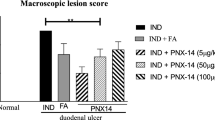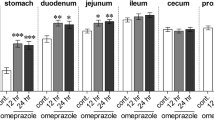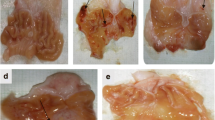Abstract
Proton pump inhibitors (PPIs) have been shown to be effective in preventing gastric and duodenal ulcers in high-risk patients taking nonsteroidal anti-inflammatory drugs (NSAIDs); by contrast, scarce information is available concerning the effects of PPIs on intestinal damage induced by NSAIDs in humans or in experimental animals. We examined the effects of lansoprazole and omeprazole on the intestinal injury induced by indomethacin in the conscious rat. PPIs were administered by the intragastric route at 30, 60 and 90 μmol/kg, 12 h and 30 min before and 6 h after indomethacin treatment. The effects of omeprazole and lansoprazole were evaluated on: (1) macroscopic and histologic damage; (2) mucosal polymorphonuclear cell infiltration; (3) oxidative tissue damage and (4) bacterial translocation from lumen into the intestinal mucosa. Lansoprazole and omeprazole (at 90 μmol/kg) significantly decreased (P<0.01) the macroscopic and histologic damage induced by indomethacin in the rat small intestine. Furthermore, both drugs greatly reduced (P<0.01) the associated increases in myeloperoxidase levels and lipid peroxidation induced by indomethacin, whereas they only moderately affected (P<0.05) the translocation of enterobacteria from lumen into the intestinal mucosa. These data demonstrate that omeprazole and lansoprazole can protect the small intestine from the damage induced by indomethacin in the conscious rat. The intestinal protection, possibly related to antioxidant and anti-inflammatory properties of these drugs, may suggest new therapeutic uses of PPIs in intestinal inflammatory diseases.



Similar content being viewed by others
Abbreviations
- CD:
-
Crohn’s disease
- CFU:
-
colony-forming unit
- CMC:
-
carboxymethylcellulose
- COX:
-
cyclooxygenase
- HTAB:
-
hexadecyl trimethyl ammonium bromide
- IBD:
-
inflammatory bowel disease
- MDA:
-
malondialdheyde
- MPO:
-
myeloperoxidase
- NSAID:
-
nonsteroidal anti-inflammatory drug
- PG:
-
prostaglandin
- PPI:
-
proton pump inhibitor
- TBARS:
-
thiobarbituric acid reactive substances
- TSA:
-
tryptone soya agar
- UC:
-
ulcerative colitis
References
Agastya G, West BC, Callahan JM (2000) Omeprazole inhibits phagocytosis and acidification of phagolysosomes of normal human neutrophils in vitro. Immunopharmacol Immunotoxicol 22:357–372
Anthony A, Dhillon AP, Nygard G, Hudson M, Piasecki C, Strong P, Trevethick MA, Clayton NM, Jordan CC, Pounder RE, Wakefield AJ (1993) Early histological features of small intestinal injury induced by indomethacin. Aliment Pharmacol Ther 7:29–39
Anthony A, Pounder RE, Dhillon AP, Wakefield AJ (2000) Similarities between ileal Crohn’s disease and indomethacin experimental jejunal ulcers in the rat. Aliment Pharmacol Ther 14:241–245
Basivireddy J, Vasudevan A, Jacob M, Balasubramanian KA (2002) Indomethacin-induced mitochondrial dysfunction and oxidative stress in villus enterocytes. Biochem Pharmacol 64:339–349
Beck WS, Schneider HT, Dietzel K, Neurnberg B, Brune K (1990) Gastrointestinal ulcerations induced by anti-inflammatory drugs in rats: physicochemical and biochemical factors involved. Arch Toxicol 64:210–217
Biswas K, Bandyopadhyay U, Chattopadhyay I, Varadaraj A, Ali E, Banerjee RK (2003) A novel antioxidant and antiapoptotic role of omeprazole to block gastric ulcer through scavenging of hydroxyl radical. J Biol Chem 278:10993–11001
Bjarnason I, Hayllar J, MacPherson AJ, Russell AS (1993) Side effects of nonsteroidal anti-inflammatory drugs on the small and large intestine in humans. Gastroenterology 104:1832–1847
Blandizzi C, Fornai M, Colucci R, Natale G, Lubrano V, Vassalle C, Antonioli L, Lazzeri G, Del Tacca M (2005) Lansoprazole prevents experimental gastric injury induced by non-steroidal anti-inflammatory drugs through a reduction of mucosal oxidative damage. World J Gastroenterol 11:4052–4060
Bradley PP, Priebat DA, Christensen RD, Rothstein G (1982) Measurement of cutaneous inflammation: estimation of neutrophil content with an enzyme marker. J Invest Dermatol 78:206–209
Elson CO, Sartor RB, Tennyson GS, Riddell RH (1995) Experimental models of inflammatory bowel disease. Gastroenterology 109:1344–1367
Fornai M, Natale G, Colucci R, Tuccori M, Carazzina G, Antonioli L, Baldi S, Lubrano V, Abramo A, Blandizzi C, Del Tacca M (2005) Mechanisms of protection by pantoprazole against NSAID-induced gastric mucosal damage. Naunyn Schmiedebergs Arch Pharmacol 372:79–87
Fortun PJ, Hawkey CJ (2005) Nonsteroidal anti-inflammatory drugs and the small intestine. Curr Opin Gastroenterol 21:169–175
Goldstein JL (2004) Challenger in managing NSAID-associated gastrointestinal tract injury. Digestion 69(Suppl 1):25–33
Goldstein JL, Eisen GM, Lewis B, Gralnek IM, Zlotnick S, Fort JG, Investigators (2005) Video capsule endoscopy to prospectively assess small bowel injury with celecoxib, naproxen plus omeprazole and placebo. Clin Gastroenterol Hepatol 3:133–141
Graham DY, Agrawal NM, Campbell DR, Haber MM, Collis C, Lukasik NL, Huang B (2002) Ulcer prevention in long-term users of nonsteroidal anti-inflammatory drugs: results of a double-blind, randomized, multicenter, active- and placebo-controlled study of misoprostol vs. lansoprazole. Arch Int Med 162:169–175
Grinstein S, Nanda A, Lukacs G, Rotstein O (1992) V-ATPases in phagocytic cells. J Exp Biol 172:179–192
Halliwell B, Zhao K, Whiteman M (2000) The gastrointestinal tract: a major site of antioxidant action? Free Rad Res 33:819–830
Hanauer SB (2006) Inflammatory bowel disease: epidemiology, pathogenesis and therapeutic opportunities. Inflamm Bowel Dis 12(Suppl 1):S3–S9
Hawkey CJ, Karrasch JA, Szczepanski L, Walker DG, Barkun A, Swannell AJ, Yeomans ND (1998) Omeprazole compared with misoprostol for ulcers associated with nonsteroidal anti-inflammatory drugs: Omeprazole versus Misoprostol for NSAID-induced Ulcer Management (OMNIUM) Study Group. N Engl J Med 338:727–734
Heinzow U, Schlegelberger T (1994) Omeprazole in ulcerative colitis. Lancet 343:477
Hersey SJ, Sachs G (1995) Gastric acid secretion. Physiol Rev 75:155–189
Ichikawa H, Yoshida N, Takagi T, Tomatsuri N, Katada K, Isozaki Y, Uchiyama K, Naito Y, Okanoue T, Yoshikawa T (2004) Lansoprazole ameliorates intestinal mucosal damage induced by ischemia-reperfusion in rats. World J Gastroenterol 10:2814–2817
Kobayashi T, Ohta Y, Inui K, Yoshino J, Nakazawa S (2002) Protective effect of omeprazole against acute gastric mucosal lesions induced by compound 48/80, a mast cell degranulator, in rats. Pharmacol Res 46:75–84
Konaka A, Kato S, Tanaka A, Kunikata T, Korolkiewicz R, Takeuchi K (1999) Roles of enterobacteria, nitric oxide and neutrophils in pathogenesis of indomethacin-induced small intestinal lesions in rats. Pharmacol Res 40:517–524
Kunikata T, Tanaka A, Miyazawa T, Kato S, Takeuchi K (2002) 16,16-Dimethyl prostaglandin E2 inhibits indomethacin-induced small intestinal lesions through EP3 and EP4 receptors. Dig Dis Sci 47:894–904
Kuroda M, Yoshida N, Ichikawa H, Takagi T, Okuda T, Naito Y, Okanoue T, Yoshikawa T (2006) Lansoprazole, a proton pump inhibitor, reduces the severity of indomethacin-induced rat enteritis. Int J Mol Med 17:89–93
Kwiecien S, Brzozowski T, Konturek SJ (2002) Effects of reactive oxygen species action on gastric mucosa in various models of mucosal injury. J Physiol Pharmacol 53:39–50
Lai KC, Lam SK, Chu KM, Hui WM, Kwok KF, Wong BC, Hu HC, Wong WM, Chan OO, Chan CK (2003) Lansoprazole reduces ulcer relapse after eradication of Helicobacter pylori in nonsteroidal anti-inflammatory drug users: a randomized trial. Aliment Pharmacol Ther 18:829–836
Laine L (2001) Approaches to nonsteroidal anti-inflammatory drug use in the high risk patient. Gastroenterology 120:594–606
Laine L, Wogen J, Yu H (2003) Gastrointestinal health care resource utilization with chronic use of COX-2 specific inhibitors versus traditional NSAIDs. Gastroenterology 125:389–395
Lapenna D, de Gioia S, Ciofani G, Festi D, Cuccurullo F (1996) Antioxidant properties of omeprazole. FEBS Lett 382:189–192
Morini G, Grandi D, Arcari ML, Bertaccini G (1995) Gastroprotective activity of the novel proton pump inhibitor lansoprazole in the rat. Gen Pharmacol 26:1021–1025
Natale G, Lazzeri G, Lubrano V, Colucci R, Vassalle C, Fornai M, Blandizzi C, Del Tacca M (2004) Mechanisms of gastroprotection by lansoprazole pretreatment against experimentally induced injury in rats: role of mucosal oxidative damage and sulfhydryl compounds. Toxicol Appl Pharmacol 195:62–72
Ohara T, Arakawa T (1999) Lansoprazole decreases peripheral blood monocytes and intercellular adhesion molecole-1 positive mononuclear cells. Dig Dis Sci 44:1710–1715
Podolsky DK (2002) Inflammatory bowel disease. N Engl J Med 347:417–429
Reuter BK, Davies NM, Wallace JL (1997) Nonsteroidal anti-inflammatory drug enteropathy in rats: role of permeability, bacteria and enterohepatic circulation. Gastroenterology 112:109–117
Robert A, Asano T (1997) Resistance of germ-free rats to indomethacin-induced intestinal lesions. Prostaglandins 14:333–341
Robinson M (2004) Review article: the pharmacodynamics and pharmacokinetics of proton pump inhibitors: overview and clinical implications. Aliment Pharmacol Ther 20(Suppl 6):1–10
Satoh H, Inatomi N, Nagaya H, Inada I, Nohara A, Nakamura N, Maki Y (1989) Antisecretory and antiulcer activities of a novel proton pump inhibitor AG-1749 in dogs and rats. J Pharmacol Exp Ther 248:806–815
Seensalu R, Girma K, Romell B, Nilsson G (1990) Time course of inhibition of gastric acid secretion by omeprazole and ranitidine in gastric fistula rats. Eur J Pharmacol 180:145–152
Simon WA, Sturm E, Hartmann HJ, Weser U (2006) Hydroxyl radical scavenging reactivity of proton pump inhibitors. Biochem Pharmacol 71:1337–1341
Somasundaram S, Sightorsson G, Simpson RJ, Watts J, Jacob M, Tavares IA, Rafi S, Roseth A, Foster R, Price AB, Wrigglesworth JM, Bjarnason I (2000) Uncoupling of intestinal mitochondrial oxidative phosphorylation and inhibition of cyclooxygenase are required for the development of NSAID-enteropathy in the rat. Aliment Pharmacol Ther 14:639–650
Suzuki M (1995) Lansoprazole inhibits oxygen-derived free radical production from neutrophils activated by Helicobacter pylori. J Clin Gastroenterol 20(Suppl 2):S93–S96
Suzuki M, Mori M, Miura S, Suematsu M, Fukumura D, Kimura H, Ishii H (1996) Omeprazole attenuates oxygen-derived free radical production from human neutrophils. Free Rad Biol Med 21:727–731
Takahashi S, Yamazaki T, Okabe S (1997) Leminoprazole protects cultured gastric mucosal cells against damage caused by ethanol, indomethacin and taurocholate. Pharmacology 54:118–126
Thiéfin G, Beaugerie L (2005) Toxic effects of nonsteroidal antiinflammatory drugs on the small bowel, colon and rectum. Joint Bone Spine 72:286–294
Thomson RD, Lestina LS, Bensen SP, Toor A, Maheshwari Y, Ratcliffe NR (2002) Lansoprazole-associated microscopic colitis: a case series. Am J Gastroenterol 97:2908–2913
Tsuji S, Sun WH, Tsujii M, Kawai N, Kimura A, Kakiuchi Y, Yasumaru S, Komori M, Murata H, Sasaki Y, Kawano S, Hori M (2002) Lansoprazole induces mucosal protection through gastrin receptor-dependent up-regulation of cyclooxygenase-2 in rats. J Pharmacol Exp Ther 303:1301–1308
Uchiyama M, Mihara M (1978) Determination of malonaldehyde precursor in tissues by thiobarbituric acid test. Anal Biochem 86:271–278
Wallace JL, Keenan CM, Granger DN (1990) Gastric ulceration induced by nonsteroidal anti-inflammatory drugs is a neutrophil-dependent process. Am J Physiol 259:G462–G467
Wandall JH (1992) Effects of omeprazole on neutrophil chemotaxis, superoxide production, degranulation, and translocation of cytochrome b-245. Gut 33:617–621
Whittle BJR (2004) Mechanisms underlying intestinal injury induced by anti-inflammatory COX inhibitors. Eur J Pharmacol 500:427–439
Wilcox GM, Mattia A (2002) Collagenous colitis associated with lansoprazole. J Clin Gastroenterol 34:164–166
Wolfe MM, Lichtenstein DR, Singh G (1999) Gastrointestinal toxicity of nonsteroidal antiinflammatory drugs. N Engl J Med 340:1888–1899
Yamada T, Grisham MB (1991) Role of neutrophil-derived oxidants in the pathogenesis of intestinal inflammation. Klin Wochenschr 69:988–994
Yamada T, Deitch E, Specian RD, Perry MA, Sartor RB, Grisham MB (1993) Mechanisms of acute and chronic intestinal inflammation induced by indomethacin. Inflammation 17:641–662
Yeomans ND, Tulassay Z, Juhasz L, Racz I, Howard JM, van Rensburg CJ, Swannel AJ, Hawkey CJ (1998) A comparison of omeprazole with ranitidine for ulcers associated with nonsteroidal antiinflammatory drugs. Acid Suppression Trial: Ranitidine versus Omeprazole for NSAID-associated Ulcer Treatment (ASTRONAUT) Study Group. N Engl J Med 338:719–726
Yoshida N, Yoshikawa T, Tanaka Y, Fujita N, Kassai K, Naito Y, Kondo M (2000) A new mechanism for anti-inflammatory actions of proton pump inhibitors: inhibitory effects on neutrophil-endothelial cell interactions. Aliment Pharmacol Ther 14(Suppl 1):74–81
Zedtwitz-Liebenstein K, Wenisch C, Patruta S, Parschalk B, Daxböck F, Graninger W (2002) Omeprazole treatment diminishes intra- and extracellular neutrophil reactive oxygen production and bactericidal activity. Crit Care Med 30:1118–1122
Acknowledgements
This work was supported by a grant from the Italian Ministry of Education, University and Research.
Author information
Authors and Affiliations
Corresponding author
Rights and permissions
About this article
Cite this article
Pozzoli, C., Menozzi, A., Grandi, D. et al. Protective effects of proton pump inhibitors against indomethacin-induced lesions in the rat small intestine. Naunyn-Schmied Arch Pharmacol 374, 283–291 (2007). https://doi.org/10.1007/s00210-006-0121-y
Received:
Accepted:
Published:
Issue Date:
DOI: https://doi.org/10.1007/s00210-006-0121-y




